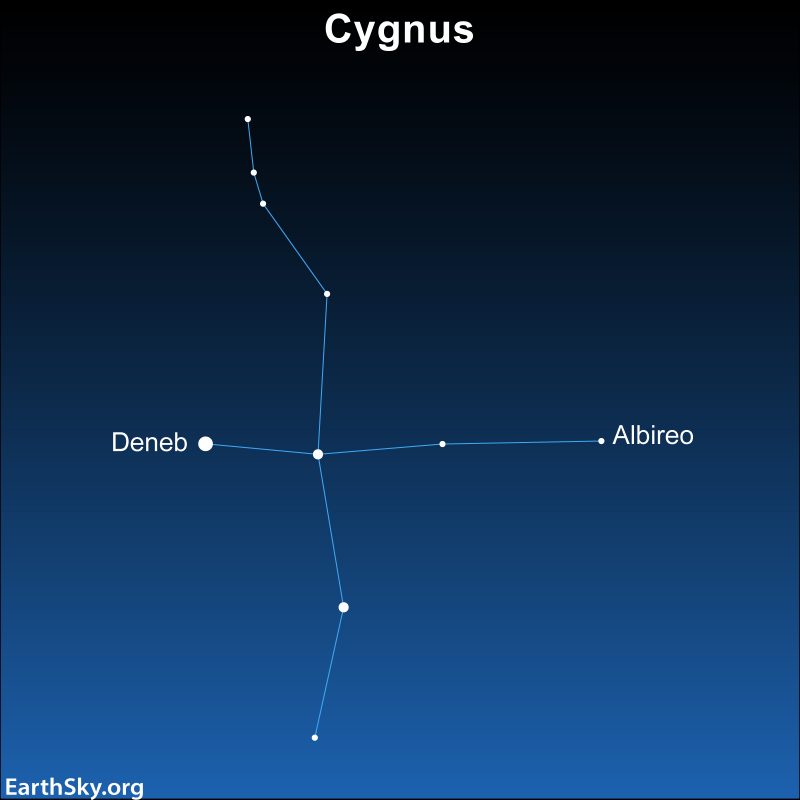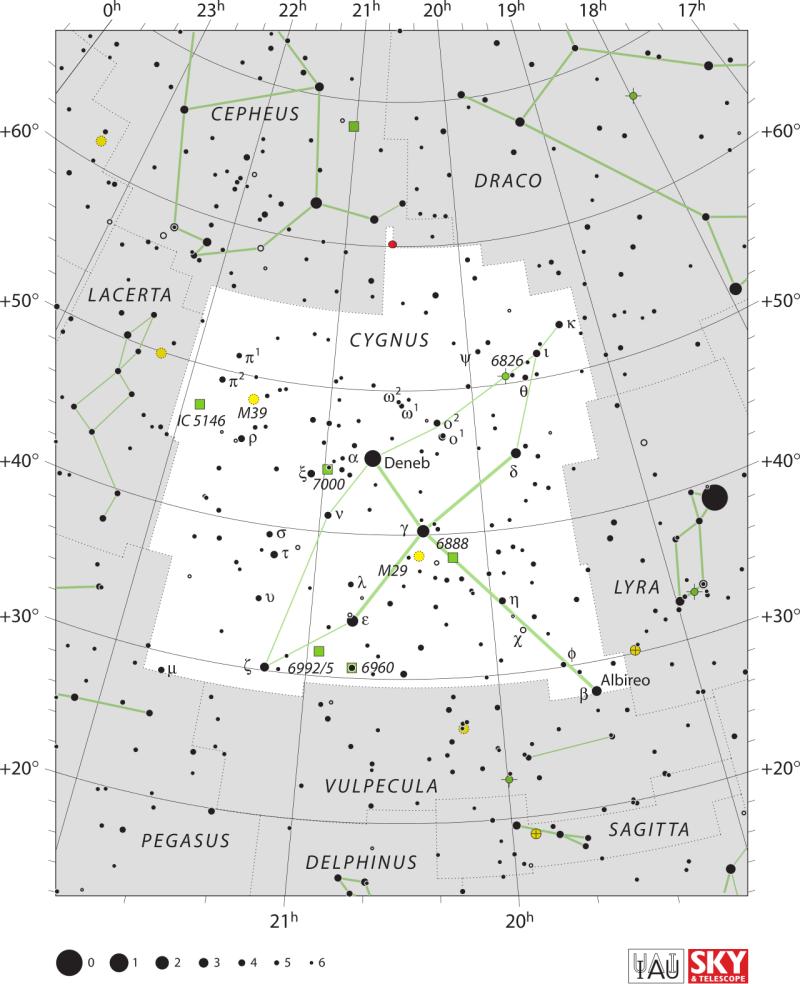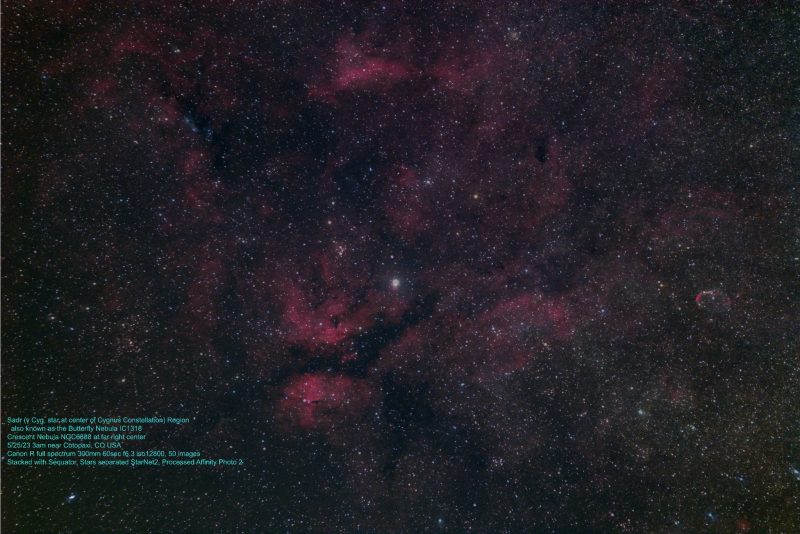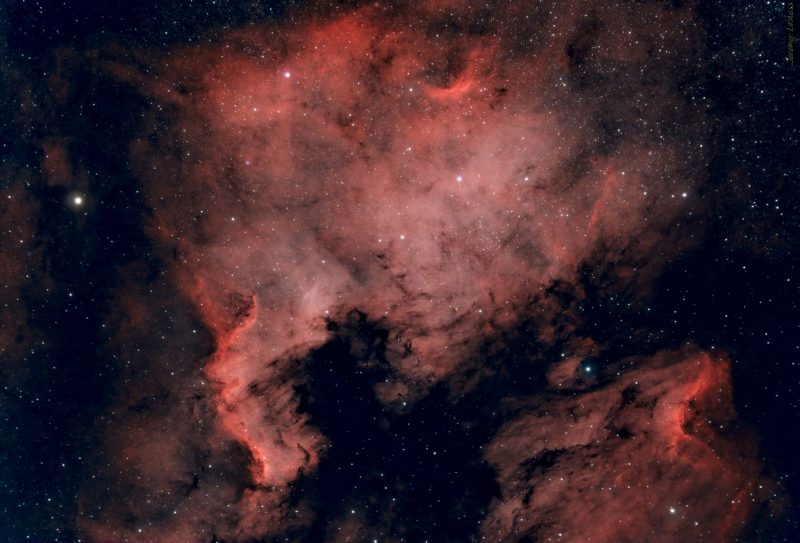
If you have a dark sky, it’s easy to see the edgewise view into our own galaxy – our Milky Way – spun across the heavens. As you look toward it, you’ll be gazing toward the constellation Cygnus the Swan, too. Its brightest star is called Deneb, the Swan’s Tail. And the constellation Cygnus contains one of the most beloved double stars in the sky, blue and gold Albireo.
Plus, the star Deneb marks one of the corners of the famous Summer Triangle, an asterism composed of three bright stars in three different constellations.
So there’s a lot going on in this part of the sky! And no wonder, because the Swan lets you peer into the depths of the Milky Way.
How to find Cygnus the Swan
Currently, you can find Cygnus high above the eastern horizon after sunset in summer. As the sky grows dark, the first of its stars that you’ll see is Deneb, the brightest in the constellation at magnitude 1.25. Deneb is the tail feather of the Swan, or the top of the lowercase “t” shape. In addition, Cygnus also has the nickname of the Northern Cross.
Later, as the night wears on, you’ll be able to trace out the body of the Swan and its bent wings. Then, you can find the double star, Albireo, which marks its head.
If you can find the large Summer Triangle shape, Deneb in Cygnus is the star that lies toward the northeast.
Then once you’ve found Cygnus, you just need to look along its length to find the hazy cloud behind it that is our galaxy, the Milky Way. The Milky Way, notably, runs along the same axis as the long line of the lowercase t or the body of the Swan.

The Swan in skylore
The mythology of Cygnus tells the story of Zeus, who changed into the form of a swan to entice Queen Leda. From their union came the twins Castor and Pollux.
Now, we see them today as the bright stars of the constellation Gemini the Twins.
Stars of the Swan
Deneb, or Alpha Cygni, is the 19th brightest star in the sky. At magnitude 1.25, it’s a blue-white supergiant star lying about 1,500 light-years away, which is a long distance for a star that shines so brightly in our skies.
Albireo, the head of the Swan, is largely regarded as the most beautiful double star in the heavens. Indeed, you can easily divide Albireo into a larger yellow star and smaller blue star in a small telescope. The brighter star of Albireo (or Beta Cygni) is magnitude 3.1, and the dimmer is magnitude 5.8. The stars are approximately 380 light-years distant.
Omicron Cygni, or 30 and 31 Cygni, is a double star with orange and blue components that you can see with binoculars. These stars lie between Deneb and Delta Cygni, which is the western wing of the Swan. At magnitudes 4.8 and 3.8, 30 and 31 Cygni lie 610 and 1.350 light-years away, respectively.
Gliese 777 is a yellow subgiant star shining at 5.71 magnitude and located about 51 light-years distant. Two extrasolar planets have been confirmed in its system.

Deep-sky objects in Cygnus
In addition, you can find an open cluster in Cygnus lying less than 2 degrees from Sadr, or Gamma Cygni, the third brightest star of the constellation, at magnitude 2.23, at the center of the cross or Swan. This open cluster is M29, at magnitude 7.1. With this in mind, try using binoculars to track it down.
Also, another Messier object in Cygnus is M39, an open cluster lying about 9 degrees northeast of Deneb. M39 is magnitude 5.5. In this case, you can try to spot with just your eyes alone.
Sadr and star clusters
Now, head back to Sadr. A 7.4-magnitude open cluster, NGC 6910, lies just a 1/2 degree north of the star. Scanning along the western boundary of Cygnus with binoculars or a telescope reveals other clusters, including the magnitude 7.3 Foxhead Cluster (NGC 6819) and the 6.8-magnitude Hole-in-a-Cluster (NGC 6811).
Also, on the western side of the constellation, 5 1/2 degrees north of Sadr, or Gamma Cygni, is the 8.8 magnitude Blinking Planetary, NGC 6826. To be sure, as you move your eyes across it, does it appear to blink?

North America and Veil nebulae
The North America Nebula, or NGC 7000, lies a little over 3 degrees east of Deneb. When you look at it in photos, can you trace out the shape of the continent for which it’s named? You can glimpse this large nebula under dark skies with binoculars. In fact, it extends up to four moon-widths. As a matter of fact, depending on your vision and sky conditions, you might detect this large 4.4 magnitude nebula with your eyes alone.
You can also use binoculars to see the Veil Nebula, or NGC 6992. The Veil Nebula spans a big sweep of sky just south of Epsilon Cygni, the eastern star in the Swan’s wing. This entire region is the Cygnus Loop and consists of the remains of a star that exploded in a supernova 5,000 years ago.

Cygnus is great to explore with binoculars
In addition to the objects mentioned above, you can explore Cygnus in binoculars. That’s because the Milky Way makes a rich background in this part of the sky. So you can find many more nebulae and clusters if you’re patient and sweep the area with binoculars or a telescope.
Bottom line: Cygnus the Swan is a constellation that lies atop the Milky Way. Also, its brightest star, Deneb, is part of the Summer Triangle.
Read more: Why 61 Cygni is nicknamed Flying Star
The post Cygnus the Swan flies along the Milky Way first appeared on EarthSky.
from EarthSky https://ift.tt/hovHs4m

If you have a dark sky, it’s easy to see the edgewise view into our own galaxy – our Milky Way – spun across the heavens. As you look toward it, you’ll be gazing toward the constellation Cygnus the Swan, too. Its brightest star is called Deneb, the Swan’s Tail. And the constellation Cygnus contains one of the most beloved double stars in the sky, blue and gold Albireo.
Plus, the star Deneb marks one of the corners of the famous Summer Triangle, an asterism composed of three bright stars in three different constellations.
So there’s a lot going on in this part of the sky! And no wonder, because the Swan lets you peer into the depths of the Milky Way.
How to find Cygnus the Swan
Currently, you can find Cygnus high above the eastern horizon after sunset in summer. As the sky grows dark, the first of its stars that you’ll see is Deneb, the brightest in the constellation at magnitude 1.25. Deneb is the tail feather of the Swan, or the top of the lowercase “t” shape. In addition, Cygnus also has the nickname of the Northern Cross.
Later, as the night wears on, you’ll be able to trace out the body of the Swan and its bent wings. Then, you can find the double star, Albireo, which marks its head.
If you can find the large Summer Triangle shape, Deneb in Cygnus is the star that lies toward the northeast.
Then once you’ve found Cygnus, you just need to look along its length to find the hazy cloud behind it that is our galaxy, the Milky Way. The Milky Way, notably, runs along the same axis as the long line of the lowercase t or the body of the Swan.

The Swan in skylore
The mythology of Cygnus tells the story of Zeus, who changed into the form of a swan to entice Queen Leda. From their union came the twins Castor and Pollux.
Now, we see them today as the bright stars of the constellation Gemini the Twins.
Stars of the Swan
Deneb, or Alpha Cygni, is the 19th brightest star in the sky. At magnitude 1.25, it’s a blue-white supergiant star lying about 1,500 light-years away, which is a long distance for a star that shines so brightly in our skies.
Albireo, the head of the Swan, is largely regarded as the most beautiful double star in the heavens. Indeed, you can easily divide Albireo into a larger yellow star and smaller blue star in a small telescope. The brighter star of Albireo (or Beta Cygni) is magnitude 3.1, and the dimmer is magnitude 5.8. The stars are approximately 380 light-years distant.
Omicron Cygni, or 30 and 31 Cygni, is a double star with orange and blue components that you can see with binoculars. These stars lie between Deneb and Delta Cygni, which is the western wing of the Swan. At magnitudes 4.8 and 3.8, 30 and 31 Cygni lie 610 and 1.350 light-years away, respectively.
Gliese 777 is a yellow subgiant star shining at 5.71 magnitude and located about 51 light-years distant. Two extrasolar planets have been confirmed in its system.

Deep-sky objects in Cygnus
In addition, you can find an open cluster in Cygnus lying less than 2 degrees from Sadr, or Gamma Cygni, the third brightest star of the constellation, at magnitude 2.23, at the center of the cross or Swan. This open cluster is M29, at magnitude 7.1. With this in mind, try using binoculars to track it down.
Also, another Messier object in Cygnus is M39, an open cluster lying about 9 degrees northeast of Deneb. M39 is magnitude 5.5. In this case, you can try to spot with just your eyes alone.
Sadr and star clusters
Now, head back to Sadr. A 7.4-magnitude open cluster, NGC 6910, lies just a 1/2 degree north of the star. Scanning along the western boundary of Cygnus with binoculars or a telescope reveals other clusters, including the magnitude 7.3 Foxhead Cluster (NGC 6819) and the 6.8-magnitude Hole-in-a-Cluster (NGC 6811).
Also, on the western side of the constellation, 5 1/2 degrees north of Sadr, or Gamma Cygni, is the 8.8 magnitude Blinking Planetary, NGC 6826. To be sure, as you move your eyes across it, does it appear to blink?

North America and Veil nebulae
The North America Nebula, or NGC 7000, lies a little over 3 degrees east of Deneb. When you look at it in photos, can you trace out the shape of the continent for which it’s named? You can glimpse this large nebula under dark skies with binoculars. In fact, it extends up to four moon-widths. As a matter of fact, depending on your vision and sky conditions, you might detect this large 4.4 magnitude nebula with your eyes alone.
You can also use binoculars to see the Veil Nebula, or NGC 6992. The Veil Nebula spans a big sweep of sky just south of Epsilon Cygni, the eastern star in the Swan’s wing. This entire region is the Cygnus Loop and consists of the remains of a star that exploded in a supernova 5,000 years ago.

Cygnus is great to explore with binoculars
In addition to the objects mentioned above, you can explore Cygnus in binoculars. That’s because the Milky Way makes a rich background in this part of the sky. So you can find many more nebulae and clusters if you’re patient and sweep the area with binoculars or a telescope.
Bottom line: Cygnus the Swan is a constellation that lies atop the Milky Way. Also, its brightest star, Deneb, is part of the Summer Triangle.
Read more: Why 61 Cygni is nicknamed Flying Star
The post Cygnus the Swan flies along the Milky Way first appeared on EarthSky.
from EarthSky https://ift.tt/hovHs4m

Aucun commentaire:
Enregistrer un commentaire